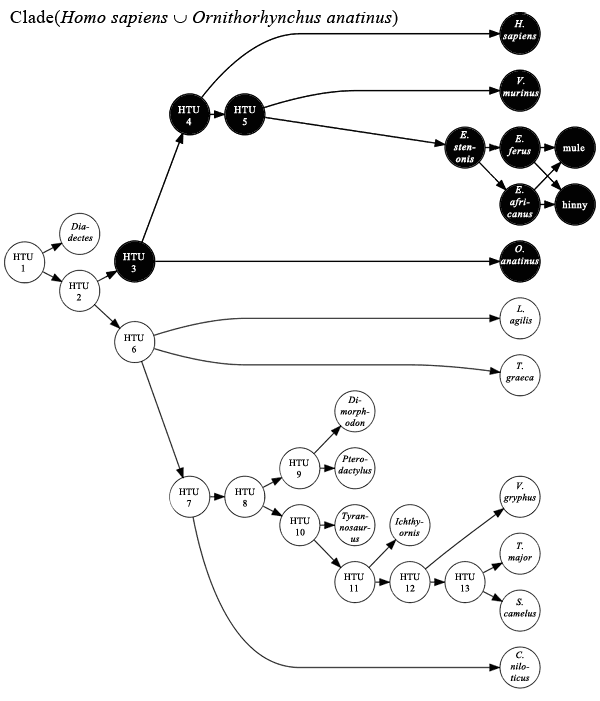How Many Taxa Per Name?
A while back I pondered a seeming contradiction between the way zoological nomenclature is practiced and what the ICZN actually says. To illustrate, let's consider the case of Columbina Illiger 1811 and Columbina Spix 1825. The former is a subtribe, typified by Genus Columba, and the latter is a genus. It's possible for Columbina Illiger 1811 to include Columbina Spix 1825, although, as I understand it, they would generally be considered disjoint taxa, with Columbina Spix 1825 in another subtribe.
In several places, it seems as though the ICZN would not allow one name to refer to different taxa. The Preamble states that one of its objectives is "to ensure that the name of each taxon is unique and distinct", and Art. 52.1 states that, "When two or more taxa are distinguished from each other they must not be denoted by the same name." Logically, it would seem that Columbina Spix 1825 should be considered invalid, and that Columbina Illiger 1811 should have priority.
But this is not how the code is interpreted. There is an understanding that homonymy only occurs within rank groups (family group, genus group, species group). Since Columbina Spix 1825 is a genus-group name and Columbina Illiger 1811 is a family-group name, they can't be homonyms. (Elsewhere, a term has been coined for such apparent homonyms: "hemihomonyms".)
This understanding is implicit. Nowhere does the ICZN explicitly lay it out. The closest it gets is in Article 53, which discusses the particulars of how homonymy works. It discusses homonymy within the family group, homonymy within the genus group, and homonymy within the species group. Nowhere does it discuss homonymy between rank groups. Only by this omission does the code hint at the idea that homonymy only occurs within rank groups.
I've communicated with several taxonomists, including people involved with the ICZN, and they all seem to agree that this is the code's intent and that the wordings in the Preamble and Art. 52.1 are confusing. Hopefully a future version of the code will clarify this.
When a Code Is Not a Namespace
So, with that more or less settled, now I'm back to my original problem. In Names on Nodes, authorities (such as nomenclatural codes) are treated as namespaces, i.e., sets of distinct names. So far as I know, there is no problem in treating the other codes (including the PhyloCode) in this manner, but apparently the ICZN does not work this way. Suppose I refer to the ICZN using a URI based on its ISBN number:
urn:isbn:0853010064. What would the qualified name urn:isbn:0853010064::Columbina refer to?Here are a few ideas I've come up with.
One Code, Three Namespaces
So the ICZN doesn't function as a namespace—but it does function as three namespaces, one for each rank group. I could use each zoological rank group as a namespace. The only problem with this is that there is no standard URI to refer to each group. At least, I don't know of any—if there is one, speak up! (I suppose I could use the draft BICI standard to refer to the particular page in the code where it defines the rank group in question, but that's a bit awkward.)
Orthographic Differences
Note that Columbina Illiger 1811 is in normal font and Columbina Spix 1825 is italicized. I could use this to distinguish the names from each other, e.g.,
urn:isbn:0853010064::Columbina (the subtribe) vs. urn:isbn:0853010064::_Columbina_ (the genus). For consistency, this would have to be done to species names as well, e.g., urn:isbn:0853010064::_Columbina+passerina_This isn't the only way to do it, though. The ICZN makes a further distinction, putting family group names in all-capital letters, e.g., COLUMBINA Illiger 1811. (Although it never states this as a rule, and most publications don't follow this convention.) I could follow this convention in the qualified names, e.g.,
urn:isbn:0853010064::COLUMBINA (the subtribe) vs. urn:isbn:0853010064::Columbina (the genus). No change would be require for qualified species names, e.g., urn:isbn:0853010064::Columbina+passerina.Augmented Local Names
Another possibility is to consider the rank group to be an essential part of the name itself. This could be reflected in a qualified name by augmenting the name with a prefix, e.g.,
urn:isbn:0853010064::fam:Columbina (the subtribe) vs. urn:isbn:0853010064::gen:Columbina (the genus). To be consistent, this would have to be applied to species names as well, e.g., urn:isbn:0853010064::sp:Columbina+passerina.What About Other Names?
The ICZN has few rules to do with names above the level of the family group, and overall it doesn't govern much about them. Thus there are all kinds of examples of homonymous taxa above the rank of family group. For example, Pterodactyloidea Plieninger 1901 is a suborder which includes Pterodactyloidea Meyer 1830, a superfamily. "Decapoda" is the name of an order-group taxon in two different phyla, Arthropoda and Mollusca. Etc., etc.
I had wanted to be able to use qualified names for all zoological names, but I'm having trouble seeing how that will be possible for those ranked above the family group. I'll probably have to use the coining publications themselves as authorities, or a URI (e.g., an LSID) for each name. Rather inconvenient.

